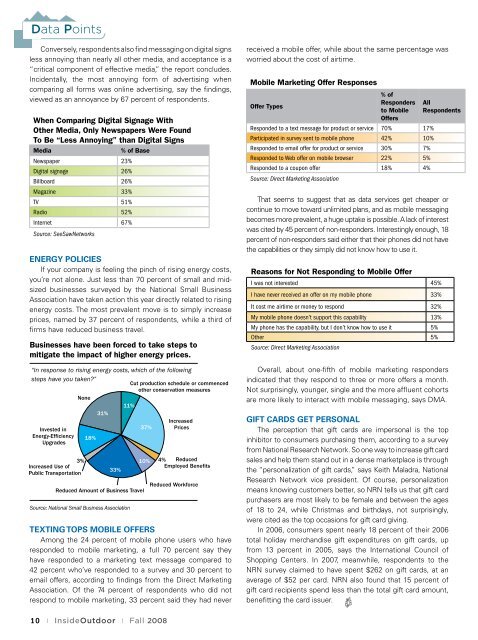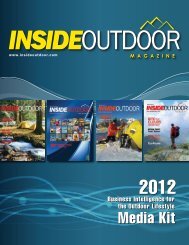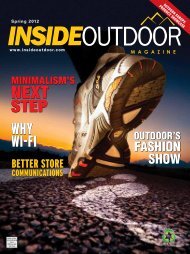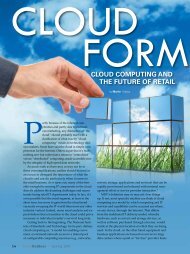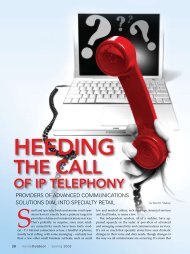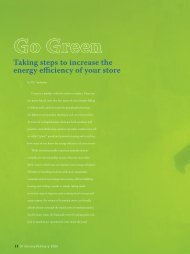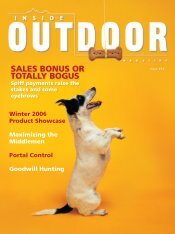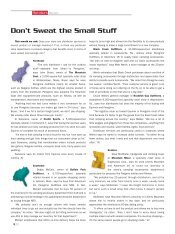Fall - InsideOutdoor Magazine
Fall - InsideOutdoor Magazine
Fall - InsideOutdoor Magazine
Create successful ePaper yourself
Turn your PDF publications into a flip-book with our unique Google optimized e-Paper software.
Data Points<br />
40%<br />
Consumers Conversely, Are respondents Most Interested also find messaging Seeing on Sale digital and signs received a mobile offer, while about the 34% same percentage 31% was<br />
less Product annoying Info than on Screen nearly all other media, and acceptance is a worried about the 30% cost of airtime.<br />
“How “critical interested component would you of be effective in seeing media,” ... on large the video report screens concludes. in stores?”<br />
21% 21%<br />
Incidentally, the most annoying form of advertising when<br />
20%<br />
15%<br />
Mobile Marketing Offer Responses<br />
12%<br />
comparing all forms was online advertising, say the findings,<br />
% of<br />
8%<br />
Specials viewed as an annoyance by 67 percent of respondents. 81%<br />
10%<br />
Responders All 3%<br />
Offer Types<br />
Products<br />
72%<br />
to Mobile Respondents<br />
0%<br />
When Comparing Digital Signage With<br />
Very often or Frequently<br />
Offers<br />
Sometimes Rarely/Never N/<br />
al Events Other Media, Only Newspapers Were Found 68%<br />
Responded to a text message always for product reador service read 70% read 17%<br />
News To Be “Less Annoying” than Digital Signs<br />
Participated in survey sent to mobile phone 42% 10%<br />
67%<br />
Source: MarketingSherpa<br />
Media<br />
% of Base<br />
Responded to email offer for product or service 30% 7%<br />
Weather<br />
67%<br />
Newspaper 23%<br />
Responded to Web offer on mobile browser 22% 5%<br />
al Shows Digital signage 26% 52%<br />
Responded to a coupon offer 18% 4%<br />
Billboard 26%<br />
Source: Direct Marketing Association<br />
Card Info<br />
50%<br />
<strong>Magazine</strong> 33%<br />
ic Videos<br />
TV 51%<br />
49%<br />
That seems to suggest that as data services get cheaper or<br />
Radio 52%<br />
continue to move toward unlimited plans, and as mobile messaging<br />
orts Info<br />
46%<br />
Internet 67%<br />
becomes more prevalent, a huge uptake is possible. A lack of interest<br />
and Trivia<br />
36%<br />
was cited by 45 percent of non-responders. Interestingly enough, 18<br />
Source: SeeSawNetworks<br />
percent of non-responders said either that their phones did not have<br />
0% 20% 40% 60% 80% 100% the capabilities or they simply did not know how to use it.<br />
Energy Policies<br />
If your company Base: is feeling Consumers the pinch 18+ of rising energy costs, Reasons for Not Responding to Mobile Offer<br />
you’re not alone. Just less than 70 percent of small and midsized<br />
Source: Arbitron businesses surveyed by the National Small Business<br />
I was not interested 45%<br />
I have never received an offer on my mobile phone 33%<br />
Association have taken action this year directly related to rising<br />
energy costs. The most prevalent move is to simply increase<br />
prices, named by 37 percent of respondents, while a third of<br />
It cost me airtime or money to respond<br />
My mobile phone doesn’t support this capability<br />
32%<br />
13%<br />
firms have reduced business travel.<br />
My phone has the capability, but I don’t know how to use it 5%<br />
A Majority of Shoppers Find Retail Video Displa<br />
Businesses have been forced to take steps to<br />
mitigate the impact of higher energy prices.<br />
“In response to rising energy costs, which of the following<br />
steps have you taken?”<br />
Cut production schedule or commenced<br />
other conservation measures<br />
None<br />
11%<br />
31%<br />
Increased<br />
Invested in<br />
37% Prices<br />
Energy-Efficiency<br />
Upgrades<br />
18%<br />
3%<br />
Increased Use of<br />
Public Transportation<br />
33%<br />
Reduced Amount of Business Travel<br />
Source: National Small Business Association<br />
10%<br />
4% Reduced<br />
Employed Benefits<br />
Reduced Workforce<br />
Texting Tops Mobile Offers<br />
Among the 24 percent of mobile phone users who have<br />
responded to mobile marketing, a full 70 percent say they<br />
have responded to a marketing text message compared to<br />
42 percent who’ve responded to a survey and 30 percent to<br />
email offers, according to findings from the Direct Marketing<br />
Association. Of the 74 percent of respondents who did not<br />
respond to mobile marketing, 33 percent said they had never<br />
10 | <strong>InsideOutdoor</strong> | <strong>Fall</strong> 2008<br />
60%<br />
50%<br />
54%<br />
Transactional email<br />
Typical opt-in messaging<br />
Other 5%<br />
to be Helpful<br />
Source: Direct Marketing Association<br />
“Do you think that video programs featuring product or sale<br />
Overall, about<br />
information<br />
one-fifth of<br />
are...?”<br />
mobile marketing responders<br />
indicated that they respond to three or more offers a month.<br />
Not surprisingly, younger, “Very single Helpful” and the more affluent cohorts<br />
are more likely to interact with<br />
16%<br />
mobile messaging, says DMA.<br />
Gift Cards Get Personal<br />
The perception that gift cards are impersonal is the top<br />
inhibitor to consumers purchasing them, according to a survey<br />
from National Research Network. So one way to increase gift card<br />
sales and help them stand out in a dense marketplace is through<br />
the “personalization “Not of at gift Allcards,” says Keith Maladra, National<br />
Research Network Helpful” vice 22% president. Of course, personalization<br />
means knowing customers better, so NRN tells us that gift card<br />
purchasers are most likely to be female and between the ages<br />
of 18 to 24, while Christmas and birthdays, not surprisingly,<br />
were cited as the top occasions for gift card giving.<br />
Base: Consumers 18+ who have seen retail video<br />
In 2006, consumers spent nearly 18 percent of their 2006<br />
total holiday merchandise Source: Arbitron gift expenditures on gift cards, up<br />
from 13 percent in 2005, says the International Council of<br />
Shopping Centers. In 2007, meanwhile, respondents to the<br />
NRN survey claimed to have spent $262 on gift cards, at an<br />
average of $52 per card. NRN also found that 15 percent of<br />
gift card recipients spend less than the total gift card amount,<br />
benefitting the card issuer.<br />
“So<br />
H


